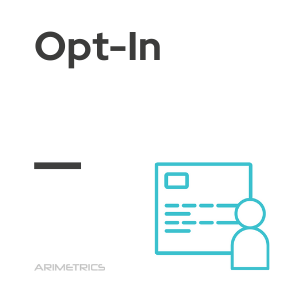
Definición:
The term opt-in refers to the act by which a user agrees to be included in a distribution list to be contacted via email or other forms of communication. If once you register in a contact list you receive a communication in which you have to click to make this registration effective, we are talking about a double opt-in.
Unlike promotional spam emails, which are sent to a long list of recipients regardless of whether or not they want the information, opt-in e-mails are sent only to people who specifically request it.
The opt-in has as antonym the opt-out, which is the action carried out by a user to leave a list of contacts.
Opt-in in Email Marketing
In Email Marketing, opt-in e-mails are targeted and often personalized, and deal with information about specific topics or promotions that users are interested in knowing. Typical opt-in emails contain newsletters, product information, or special promotional offers. For example, if a user frequented a Web site that sells books and music online, that user may “opt- in” to receive ads when their favorite musician or author releases new material. The promotional email may even present the recipient with a special promotional offer to purchase the product at a discount available only to those present on the opt-in list.
Opt-in and spam
Spammers, however, have found a way to use the opt-in feature to the benefit of spam. Spam emails often come with opt-in features in small print or obscured somewhere in the body of the email, with text saying something similar to “failure to respond to this email address will be understood as the recipient’s approval automatically to accept future submissions.” The strategy of responding to spam and asking to be removed from future shipments also has critics, as they claim that responding to a spam email can cause that address to be transmitted to other spammers.
Benefits of Opt-in Digital Marketing
The use of opt-in in digital marketing strategies offers multiple advantages for both companies and consumers:
- Consent and legal compliance: Opt-in ensures that recipients have given their explicit consent to receive communications, which helps companies comply with privacy and data protection regulations, such as GDPR in Europe.
- Better segmentation: By allowing users to opt-in to receive communications, companies can better segment their mailing lists according to interests and preferences, resulting in more effective and personalized campaigns.
- Higher engagement: Opt-in emails and newsletters tend to have higher open and click-through rates, as recipients have expressed interest in the content they receive.
- Building trusting relationships: By respecting users’ privacy and preferences, companies can build stronger and more trusting relationships with their customers.
Best Practices for Opt-in Implementation
To maximize the effectiveness of the opt-in, it is important to follow some best practices:
- Clear and simple form: Make sure the subscription form is easy to understand and complete. Include essential fields and avoid asking for too much input information.
- Clear value proposition: Communicate clearly what benefits the user will get from subscribing, whether it is exclusive content, discounts or relevant updates.
- Double opt-in process: Implement a double opt-in process to confirm user interest and avoid accidental or fraudulent subscriptions.
- Customization options: Offers users the ability to choose the frequency of communications and the types of content they wish to receive.
- Ease of unsubscribing: Provide a clear unsubscribe link in each email, allowing users to easily unsubscribe if they wish to do so.
